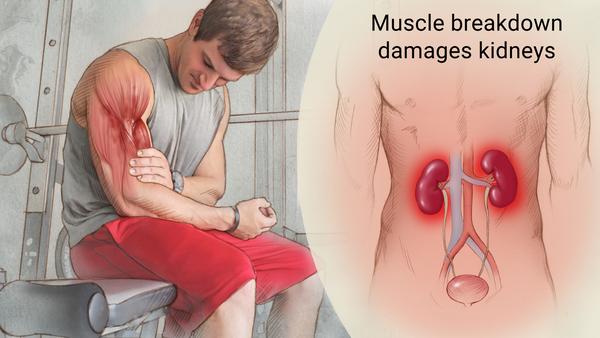“Revealing The Down and Dirty Side Of Exercise and Fitness What You Don’t Know Can Kill You!”
Huh? Kidney failure WTF! Are you serious? So you may be thinking fitness is all about being fit and healthy…
Now, before you dismiss this all together and jump ship, you definitely should take a closer look and read this post!
Listen, we’re continuously looking at ways to help better support you.
Yes! Support you in optimizing your bodyweight training, health and wellness goals…
If you’ve questions on how we can better help you, drop us a quick suggestion.
This topic is near and dear to my heart (as you’ll read in just a moment)…
And it has to do with the one word you never want to hear your Doctor utter.
Have you heard about this rare still potentially fatal muscle disorder?
It’s called rhabdomyolysis!
Or rhabdo for short…
Did you know rhabdo may affect 22 people out of 100,000?
The muscle trauma is a result of overexertion.
This is a common cause…
Your skeletal muscles are voluntary muscles which are under your volitional control.
You engage muscles walking and moving.
Now, if a skeletal muscle is damaged through overexertion injury…
The muscle starts dumping myoglobin into your bloodstream.
Myoglobin is iron rich, oxygen-binding muscle protein.
Excessive myoglobin clogs the kidney’s filtration system.
This causes inflammation which can result in acute renal damage.
Rhabdo causes kidney failure in up to 40 percent of cases…
This is why early diagnosis and rapid medical intervention is crucial.
In a recent series of papers, potassium is liberated from muscles during stimulation.
(Fenn et al., 1936, 1938a, b) leading to hyperkalemia / high potassium in blood.
That means potassium level in your blood is higher than normal.
Potassium is a chemical critical to function of nerve and muscle cells…
Including cells in your heart.
Your blood potassium level is normally 3.6 to 5.2 millimoles per liter (mmol/L).
This elevated higher levels of potassium can happen within hours after muscle injury.
However, did you know it can be life-threatening?

Here’s a checklist of rhabdo symptoms to become aware of…
Keep in mind many are not always present in all cases:
- Muscle swelling
- Pain in the affected muscle group
- Muscle weakness or trouble moving your limbs
- Dark and scanty urine output
- Nausea
- Vomiting
- Fever
- Intense shivering
- Confusion
- Dehydration
- Fainting
While it is clear rhabdomyolysis happens because of breakdown in damaged muscle tissue…
Listen, there are many situations or circumstances which can trigger symptoms.
Some of the most common include:
- Overexercising
- Pushing yourself to extremes
- Running too far beyond your limit
- Lifting weights beyond your limit
- All these activities can damage your muscles
While you’d expect muscle soreness is normal after a workout…
Rhabdo symptoms is another story.

What if pain is extreme and feels disproportionate to your exertion?
Another tip-off is if symptoms get worse rather than better over next couple of days.
Untreated…rhabdo does progressively get worse.
Accidents and blunt trauma…
Blunt trauma is initial trauma from which develops more specific types:
- Contusions
- Abrasions
- Lacerations
- Bone fractures
Blunt trauma is contrasted with penetrating trauma.
Patients who survive major accidents typically develop extensive muscular damage.
Nonaccidental injury can also cause muscle trauma that can lead to rhabdo.
Prolonged immobilization…
Being bedridden for long periods of time, such as when you suffer a stroke…
This can put pressure on muscles pressing against bed, cutting off blood flow and causing tissue death.
Drug side effects…
Cholesterol-lowering medications such as statins or fibrates usually produce muscle weakness as a side effect.
Abuse of illicit drugs such as cocaine and heroin can cause weakness as well.
Metabolic disorders…
Certain metabolic disorders can raise your risk of rhabdo.
This includes problems with metabolism of:
- Lipids (fats)
- Carbohydrates or purines
- Hypothyroidism
- Diabetic ketoacidosis
- Electrolyte imbalances
Genetic disorders…
Genetic conditions can raise your risk includes:
- Carnitine deficiency
- McArdle’s disease
- Lactate dehydrogenase deficiency
- Duchenne muscular dystrophy.
High-Intensity Repetitive Movement Is a Major Risk Factor…
According to Dr. Maureen Brogan, associate professor of medicine at New York Medical College…
Author of a 2017 papers on the condition…
He explains rhabdo can happen with any intense, repetitive motion exercise.
For example…
Spin classes (high-intensity cycling) have produced dozens of cases.
Typically among new trainers who are starting out and are working above their capacity.
One New York City hospital reports seeing 29 rhabdo cases within a four-year span.
14 of which were related to high-intensity cycling.
According to Brogan…
“The high-intensity exercise associated with spin class comes with significant risks to newcomers.”
She even goes so far as to call spinning-induced rhabo a “public health concern.”
WebMD reports:
“She says she came to see it as that after six patients came to her hospital’s ER…
And all involved people trying a cycling class for the first time…
When she searched medical literature, 42 of 46 cases she found also involved people going to cycling class for first time.
‘Those are patients that were most at risk because they may not be conditioned.
And are using plus engaging new muscle groups for first time at an intense rate, she says.
So even if you were a different type of athlete like a runner…
And then you switch to biking and use quadriceps and gluteus maximus muscles at an intense rate.
For that first time, you may be at risk of getting rhabdo’ …
People who stop cycling for some time and then go back at same rate are at risk, too.
‘Cycling is great exercise if you are conditioned for it, she says…
However, you burn 600 to 900 calories in one class.
You wouldn’t go out and run 6 to 9 miles on your first day of running would you?
If you did that you wouldn’t be able to walk either.’”
Dehydration and Extreme Temperatures Raises Your Risk…
Inadequate physical conditioning in combination with severe dehydration…
And/or extreme body temperatures raise your risk of rhabdo.
This is regardless of the exercise you’re doing.
Always make sure to stay well-hydrated before, during and after exercise.
Take a break if you start feeling excessively hot.
If you’re not conditioned to exercise in hot conditions, avoid starting new type of exercise in a heated exercise room.
When starting a new exercise, even if you feel you’re fit and up to the challenge…
Make sure you tune-in and listen to your body.
Always best to start slow…
Take breaks and work your way up to greater intensity over time.
Look, it’s important to recognize you don’t have to be in poor physical condition for rhabdo to happen.
And you don’t have to work out for an extended period of time.
One of Brogan’s patients developed rhabdo after just 15 minutes of cycling…
In fact, many rhabdo patients exercise regularly and express surprise when getting their diagnosis.
The key to remember is there’s a fine line between exercising to capacity and overexerting yourself.
For example:
Approximately 7 to 8 out of 100,000 military recruits are affected each year.
Yes, even professional athletes especially marathoners and ultramarathoners do suffer its consequences.
The Truth IS No One Is Immune to Rhabdo…
Professional snowboarder Amy Purdy was hospitalized in 2016 after participating in a CrossFit class for the first time.
While well-conditioned, she had not done pullups for a few months…
And the high-intensity, repetitive pull-ups done during class did her in.
She told WebMD:
“It wasn’t until 72 hours later, I was back in my hometown with friends at a restaurant around 11 at night.
I told them I worked out too hard a few days ago…
And my arms wouldn’t straighten all the way.
I then took my jacket off and instantly noticed swelling around my elbows on both arms.
The doctors were convinced I didn’t have it because my arms were only slightly swollen.
They decided to test me anyway.
That whole experience was one of the hardest experiences of my life!
The lesson here should be clear…
If you want to push your body to failure and keep going, you are at risk.
Learn to listen to your body because your body knows best.
And if you find yourself going on days with overly stiff…
And sore muscles and you notice swelling, get to hospital ASAP.
It may not be rhabdo, could be a simple blood test can tell.
Diagnosis usually begins with a review of your medical history.
And events which led up to your medical visit.
A variety of blood and urine tests can help diagnose rhabdo.
This checklist of tests are typically recommended:
- Complete blood count, including hemoglobin, hematocrit and platelets
- Serum chemistries
- Includes blood urea nitrogen
- Creatinine
- Glucose
- Calcium
- Potassium
- Phosphate
- Uric acid
- Liver function tests
- Prothrombin time and activated partial thromboplastin time
- Serum aldolase
- Lactate dehydrogenase
In mild cases of rhabdo, simple lifestyle changes are good for a full recovery.
This short list includes:
• Hydration: Keeping your body properly hydrated helps flush out toxins.
And ease the workload of your kidneys.
Drink clean, filtered water until your urine turns to a light-colored yellow.
• Reduce exercise: Cut back on your workout until your muscles recover and your urine normalizes.
This can help lower the amount of toxins entering your kidneys until you get better.
• Increase circulation: Improving blood circulation is vital to helping your muscles heal.
And lowering your risk of tissue death.
Gentle full-body massages and gentle movements can be helpful.
Certain foods can also help improve blood circulation.
This short list includes:
- Oranges
- Goji berries
- Dark chocolate
- Sunflower seeds
- Garlic
- Ginger
- Cayenne pepper
• Eat a nutritious diet: Optimizing your diet also improves your chances of a full recovery.
By focusing on eating organic, whole foods rich in nutrients, you nourish muscles back to recover.
This in turn is better to improve your overall well-being.
While protein is important for muscle recovery…
Avoid protein loading as excessive protein consumption.
Protein can stimulate your mTOR (mammalian target of rapamycin) for growth rather than regeneration.
This is not what you need…
To avoid this limit your intake to less than 0.5 gram of protein per pound of lean body mass.
And focus instead on eating highest-quality protein you can get.
This short list includes:
- Grass fed meats
- Raw seeds and nuts
- Pasture-raised eggs
For more serious cases of rhabdo more precise measures may be required.
An intravenous solution of special minerals may be used to counteract potential harms caused by severe muscle damage.
Electrolyte imbalances must be monitored and promptly treated as well.
And in severe cases you may need hemofiltration to address kidney damage.
Overall, prognosis of rhabdo is good as long as your blood, electrolytes, urine are closely monitored following muscle failure.
The mortality rate for rhabdo is only 5 percent…
You want to lower your risks especially where significant increase of kidney failure occurs.
If you take good care of yourself by moderating exercise, drinking enough water and getting enough rest…
You will be on your way to a successful recovery.
Of course it can take time to recover.
Purdy spent months in rehab before being able to lift even the lightest of weights.
While rhabdo is a serious condition and can happen to anyone.
Ultimtely you shouldn’t be scared from doing exercise.
The most valuable insight here is to take care and always listen to your body.
Find a midway point between easy when you first start something new or different from your regular fitness routine.
Give your body some time to adapt and don’t go all-out during the initial sessions.
Also, if you just don’t feel right following a strenuous exercise…
Keep close watch on any of the symptoms listed above.
Check the color of your urine and pay attention to pain, swelling and weakness.
If you’re feeling depressed, low on energy when you know you should be recovering, seek medical attention.
Blood tests can help diagnose problem and with proper treatment, kidney damage can be avoided.
